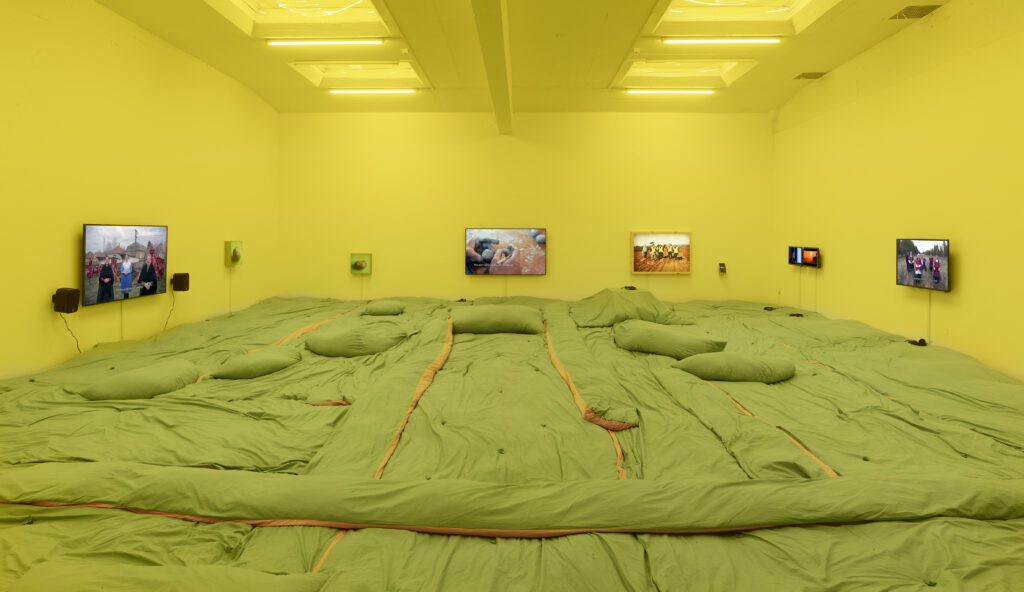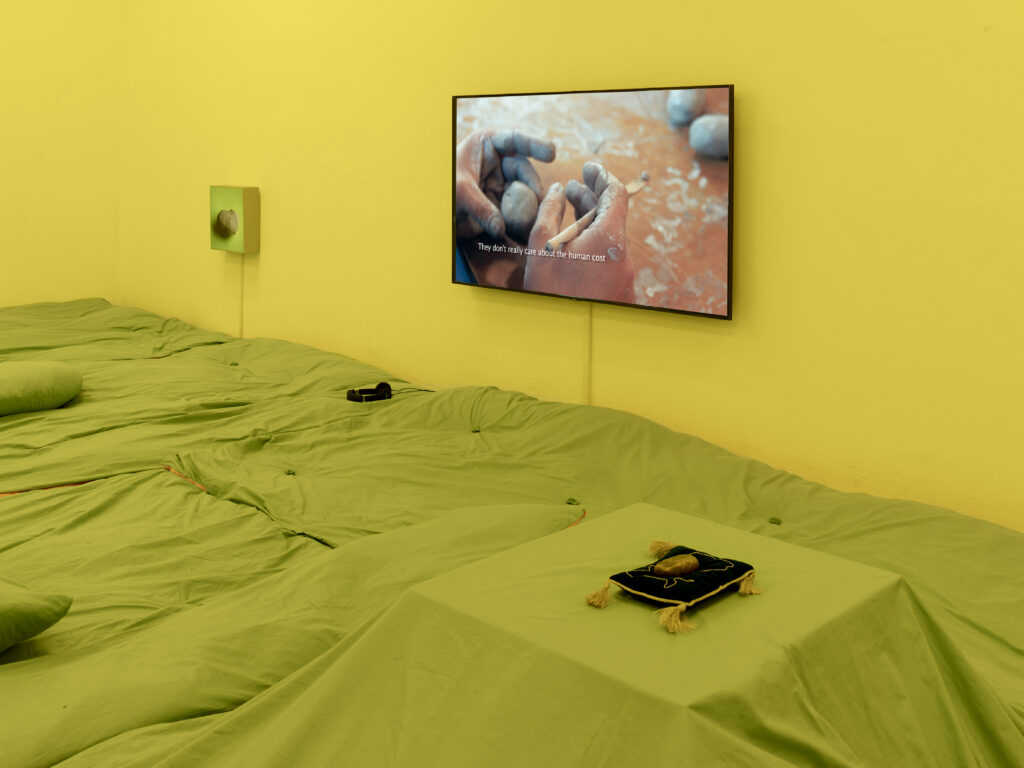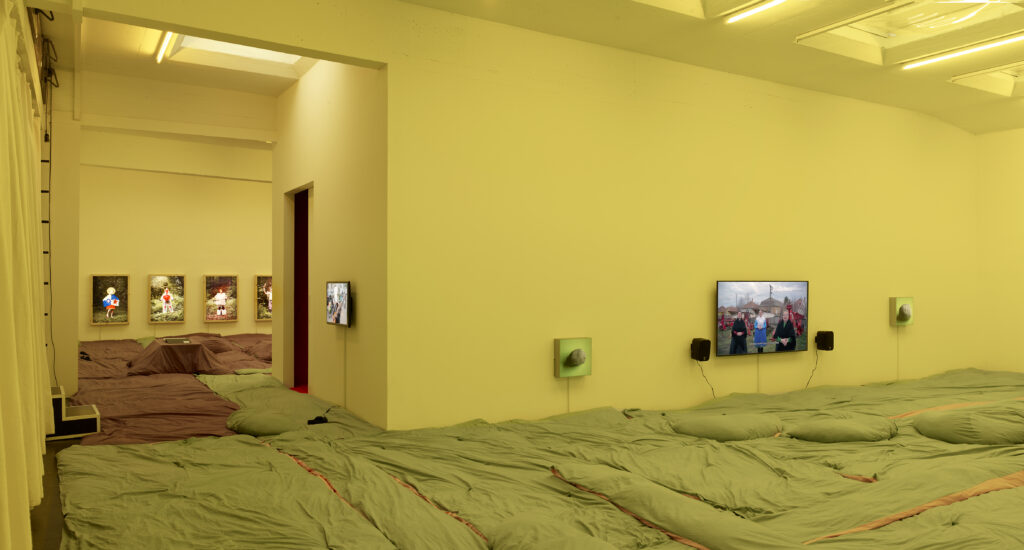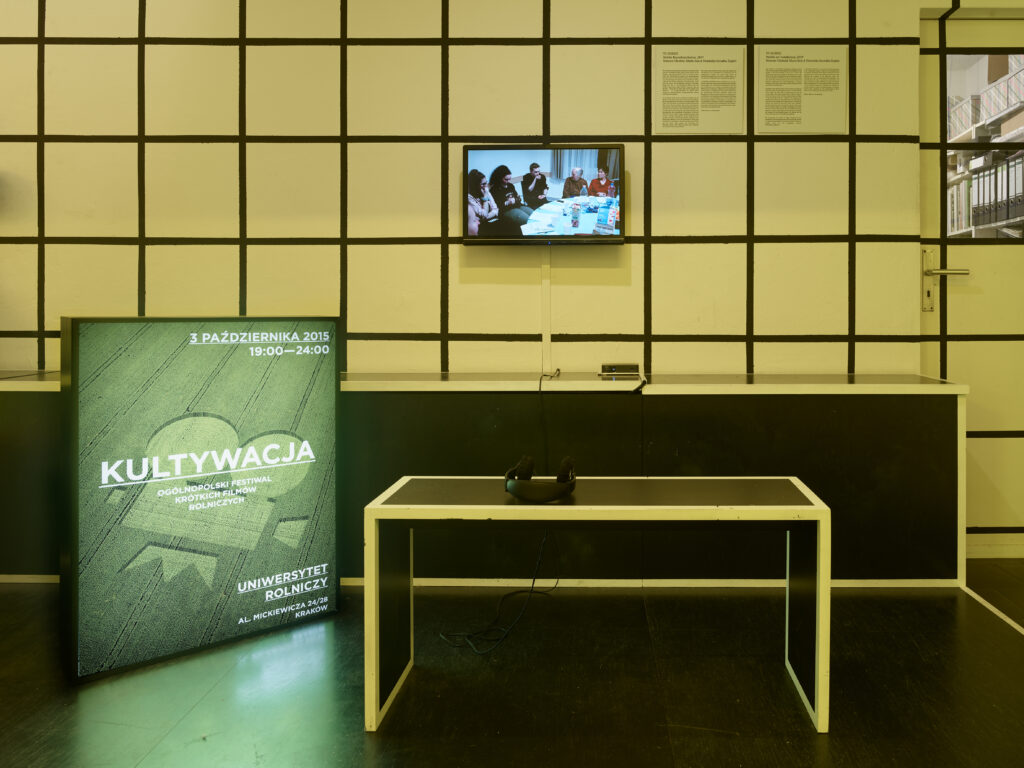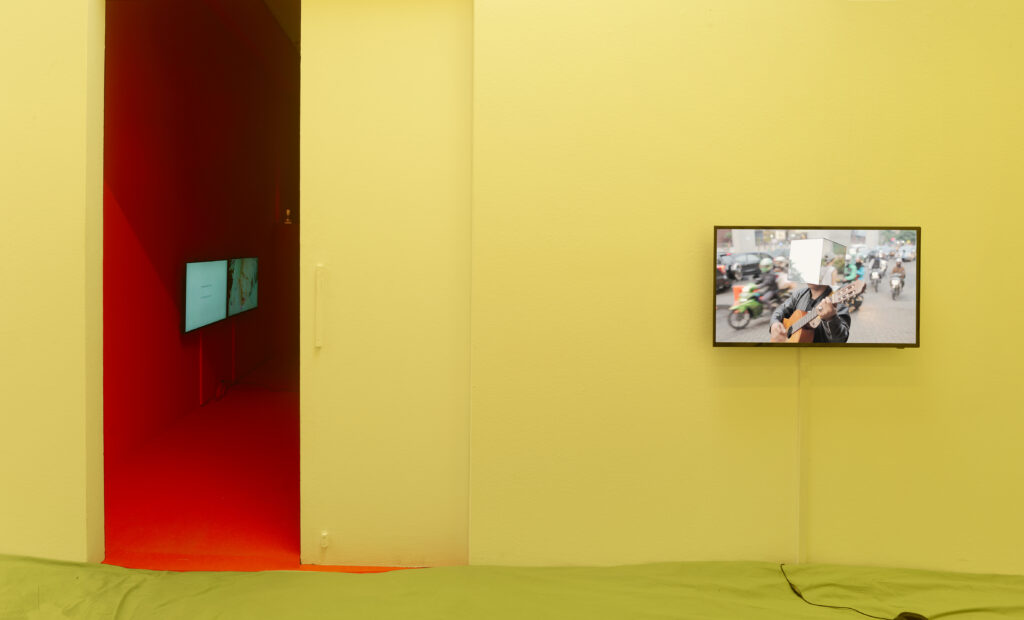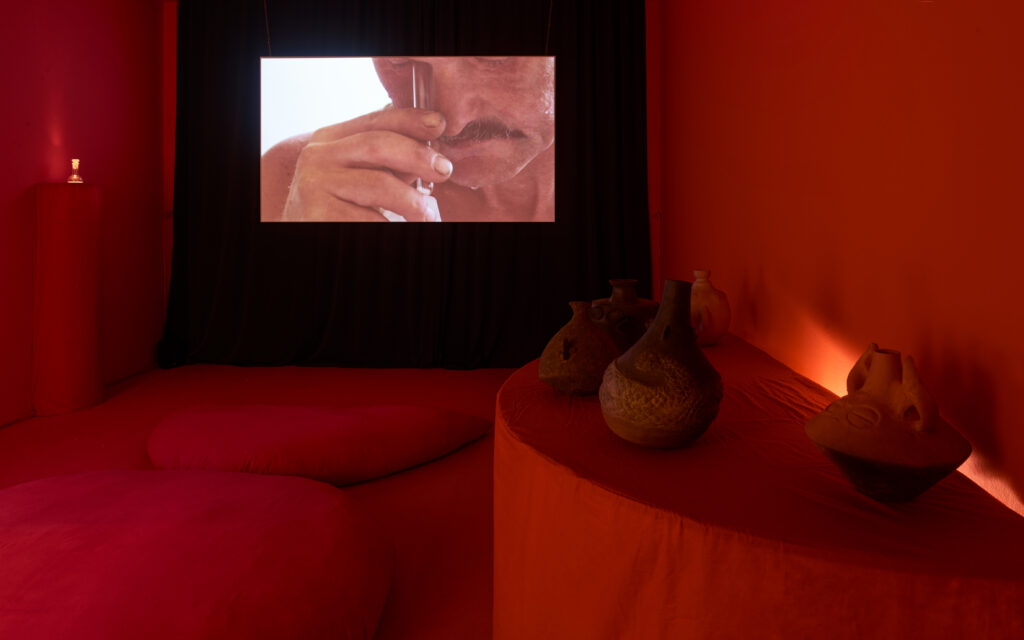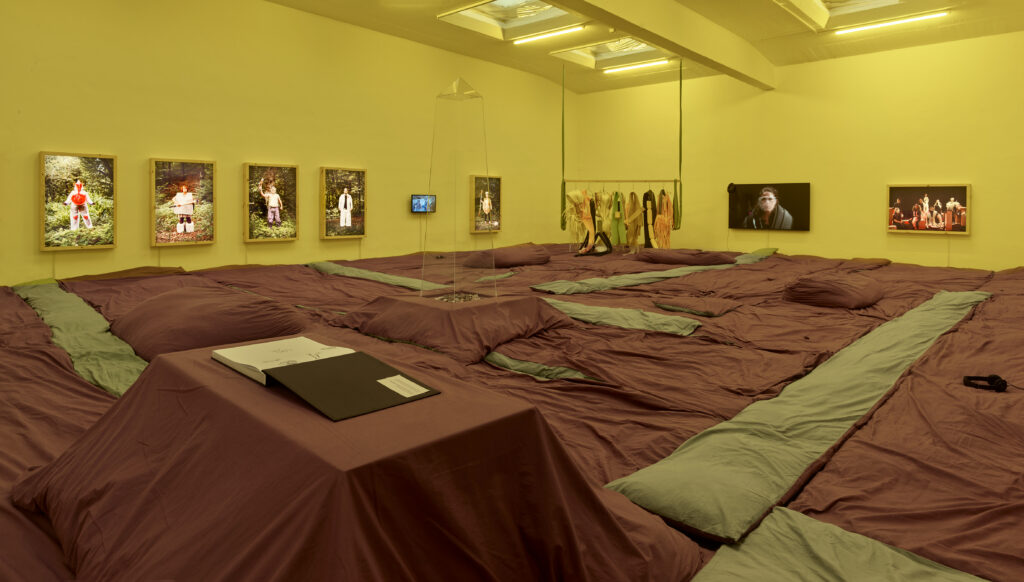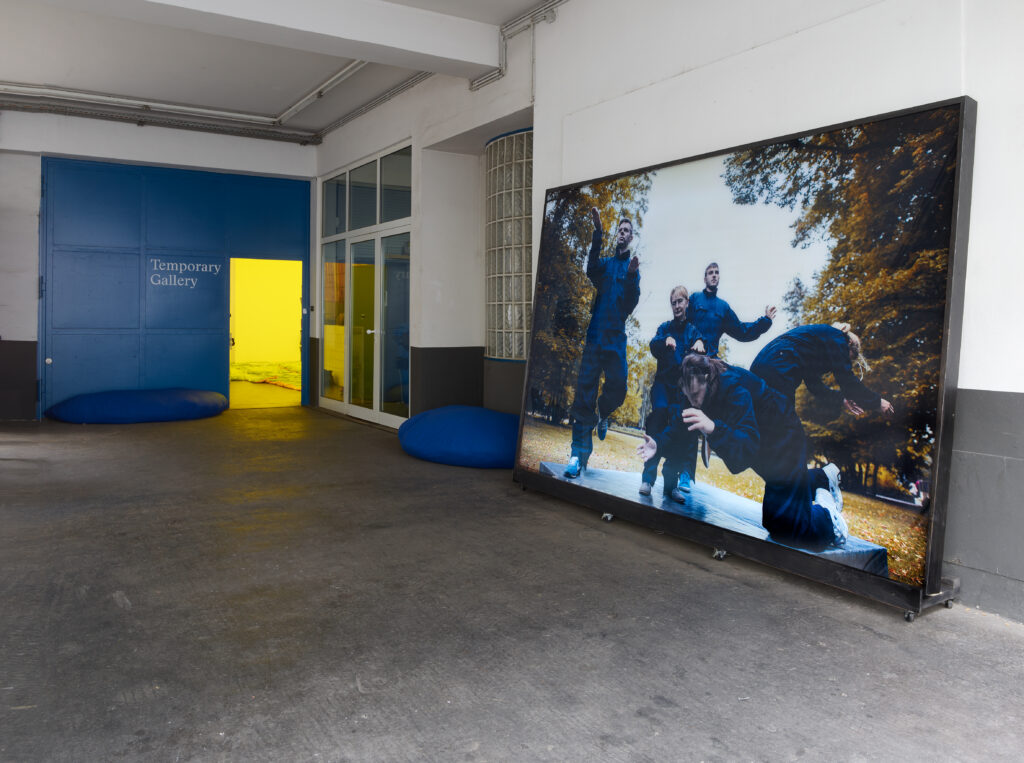FROM GROUND TO HORIZON
Alicja Rogalska
13 November 2021 — 1 May 2022
Fri 12 November, 7 p.m.
Opening with food by Pyszny Bar (Andra & Hanich)
Sat 13 November, 4 p.m.
Guided tour with the artist, the curator and the exhibition designer
Creating collaborative situations, processes and actions underpins Alicja Rogalska’s artistic practice. She often works with people who live in precarious economic and political contexts, activists and researchers: migrant workers, people who have been stripped of their citizenship, care workers, street musicians, asylum seekers trained as lawyers, young farmers, folk singing groups or feminist and queer activists. What emerges from these interactions are temporary collectives formed on the basis of a shared life situation, class, political beliefs or a commitment to social change. The videos, images and objects created through the collective processes foreground moments of agency, rebellion and solidarity. Questioning the logic of capitalism, the works attempt to carve a space for imagining other, more just possibilities.
Curated by Aneta Rostkowska, the exhibition at the Temporary Gallery, Centre for Contemporary Art in Cologne, is Rogalska’s first solo show in Germany, gathering artworks made between 2011 and 2021. It sits within an immersive, landscape-like exhibition design by Mateusz Okoński and is accompanied by a rich public programme, including an action in public space, an artist talk, a guided tour, a reading session, a lecture on socially engaged art and a wellness day for Cologne city activists. Check our website and sign up for our newsletter for more information.
The exhibition is supported by the DAAD Artists-in-Berlin Program.
It is part of the anniversary programme beuys 2021.
The flyer accompanying the exhibition contains a text by Tirdad Zolghadr.
Alicja Rogalska is a Polish-born interdisciplinary artist based in London and Berlin and working internationally. Her practice is research-led and focuses on social structures and the political subtext of the everyday. She works mostly in specific contexts making situations, performances, videos and installations in collaboration with other people to collectively search for emancipatory ideas for the future. Rogalska graduated with an MA in Cultural Studies from Warsaw University and an MFA in Fine Art from Goldsmiths College, where she is currently a PhD researcher in the Art Department. She recently presented her work at Kunsthalle Bratislava (2021), Kunsthalle Wien (Vienna, 2020—2021), OFF Biennale (Budapest, 2020—2021), Tabakalera (San Sebastian, 2020), VBKÖ (Vienna, 2019), Art Encounters Biennale (Timișoara, 2019), Tokyo Photographic Art Museum (2019), Biennale Warszawa (2019), Museum of Modern Art (Warsaw, 2019), Kyoto Art Centre (2019) and Muzeum Sztuki (Łódź, 2019). Rogalska is currently artist in residence at the Faculty of Social Sciences at Essex University (2019—2021) and the DAAD Artists-in-Berlin Program 2020 fellow. Recent residencies include City of Women Festival (Ljubljana, 2019), Stuart Hall Library (London, 2019), PARADISE AIR (Matsudo, 2018), Copenhagen International Theatre (2018), MuseumsQuartier (Vienna, 2018) and IASPIS (Stockholm, 2017).
Curatorial text accompanying the exhibition:
When I was still in primary school my aunt married a Swedish farmer. In those days, my other family members and I spent summer holidays on the farm in Sweden, helping our uncle but also earning money: we mostly harvested cucumbers but occasionally also worked on neighbouring farms weeding potatoes or beetroots and picking strawberries. For me it was a perfect arrangement: I could live in my aunt’s house and – during the days the cucumbers were growing – I was having proper holidays swimming in the lake, picking, drying and cooking mushrooms. The work was hard, we had to get up at 4 a.m. and then spend many hours on a weird machine nicknamed “The Airplane”, where we had to lay down and throw picked cucumbers onto a belt rolling underneath. The whole structure was pulled by my uncle’s tractor and the cucumbers were conveyed underneath us and then thrown into a big box. During the breaks my aunt served coffee and home-baked cakes to everybody. There were two people per cucumber bed and we could talk to each other while working, which made the time pass much quicker. I will never forget the sharp smell of cucumber plants in the morning and will forever associate it with getting up very early and being extremely tired afterwards. Almost no one in my family has a university education, so it was also a time when I socialized a lot with people that I would later, because of my educational and professional path, not have much contact with. Our being together, however, was not difficult: we found common ground in the experience of shared labour, my aunt cooked amazing Polish dinners for us and in the afternoons, we played cards. Thanks to this experience, I understood how hard farm work actually is and how little we know about the conditions in which our food is produced. All these cucumbers, tomatoes, potatoes, asparagus were in the hands of another person, the fingers of this human touched and carefully separated them from the ‘mother’ plant. Maybe many years ago you even ate a cucumber or a strawberry that I picked. Imagine that!
It was much later that I also understood how privileged my situation actually was at the time: I was paid fairly, had decent and free accommodation, friendly company, food and the care of my aunt. After a summer of working without a permit in Dublin (Poland was not in the EU yet, but I got the job thanks to the Polish pope – the owner of the restaurant was a big fan) and several weeks of picking strawberries on the German island of Fehmarn (we lived in a caravan; a photo of me and my friend working in the field even landed in a local newspaper), where on the day of final payment our boss spontaneously decided to reduce our hourly wages and each of us got a few hundred euros less, I realized that the working situation I had in Sweden was an exception rather than the rule. Usually the living conditions are much worse and the fate of the migrant worker depends on the whim of her employer. There is no balance of power and even other workers might threaten you (after all, you have a job that their family member could get next year). Years later, as a curator, I instinctively turned towards art dedicated to economic themes. My first curatorial projects focused on public art, activist art, monuments and possible alternatives to capitalism. I learnt the intricacies of socially engaged art projects, the tensions and ideological traps within them, but also the collective beauty that emerges there, and started to think of the community centre as a very good inspiration for art institutions. I respected the will of artists to influence the reality around them and to go beyond the ‘bubble’ of art or art as ‘elitist entertainment’, my family being far from any ‘elites’. To some extent when I look back, I tend to think that these experiences gave me some kind of sensitivity that informed my curatorial choices, giving additional energy and a deep conviction that art has the capacity of revealing difficult life conditions and even working against them.
It is all these experiences, I think, that make the work of Alicja Rogalska resonate within me very strongly and, indeed, our first collaboration was related to agriculture. In the context of the Art Boom Festival in 2015 in Kraków, we worked together on CULTIVATION – the National Festival of Short Agricultural Films. The event explored the popular Polish Internet phenomenon of short videos showing the harvest and other forms of agricultural labour. Many of the films are very well made, using drone cameras and carefully selected music. Alicja invited several of the farmer-filmmakers to Kraków, where we screened their works in the hall of the University of Agriculture; the farmers also nominated movies to be shown during the festival. The audience chose the winner. The movies are representations produced by the farmers themselves, a grassroots artistic production they take very seriously (there are even collectives active in this field consisting of several farmers coming together to make movies) [1]. In order to avoid decontextualizing and exoticizing the phenomenon, Alicja invited various scholars to comment on the movies from different perspectives: sociological, economic, ethnographic and political. They analysed the artworks, not withholding from pointing out some problematic aspects, as many of the farmers take out huge bank loans to buy farming equipment (although sometimes one machine per village would be enough) or are fascinated with industrial-scale food production (which actually made the local food cooperative decline our invitation to collaborate with the festival). Together with the invited guests, Alicja successfully presented a more complex image of the Polish countryside, one that goes beyond common projections and schemata. And the farmers now number among our Facebook friends, and adverts about selling 50 kilos of cabbage or 100 kilos of potatoes occasionally appear on our Facebook walls. We still hope that someday they will organize their own festival and we will be able to meet them again.
What particularly struck me while working with Alicja back then was her ability to engage with people of various social backgrounds and life experiences. The way she approaches people and develops long-term relationships with them is really extraordinary. She takes her inspirations from various sources such as alternative pedagogy, feminism, participatory theatre or community arts. Her working method usually involves creating a kind of ‘situation’, for example a workshop or a game to which she invites her subjects. The process of being within that situation is often filmed, and later the documentation is edited by the artist. An important part of the post-production process is showing the video to the participants in order to receive their feedback and approval. Alicja’s working method is respectful towards the participants; for the final result, however, she takes full responsibility herself: the encounters are very collaborative and truly adjusted to the needs of everyone involved, however, it is she who provides the framework, initiates it and does the editing later. In her artistic practice she very wisely resolves some of the fundamental tensions that usually emerge within socially engaged art. The implementation of the process is not contradicting the expectations of the participants, their integrity is valued and kept; no one is being ‘used’ here for the sake of art.
In order to dig into that theme on the occasion of this exhibition, we commissioned interviews with several participants of Alicja’s projects. The documentation of and reflection on participatory art projects almost always presents only the perspective of the artist or the curator. But how about changing the perspectives and examining how an artistic project affects the lives of other people and what they actually think about it after it has ended? Our research, the results of which you can see in the exhibition space, shows that the participants’ memories from Alicja’s projects are still vivid. After the initial disorientation brought on by getting involved in an activity that they haven’t experienced before they seem to enjoy it a lot, especially the human interaction that happens within it: with the artist, her team and other participants. Some of the interviewees felt that the connection that was made was not a superficial one. “It really wasn’t like – we brought you here, now do something and then goodbye! They were really understanding and caring!” said one participant of the The Alien’s Act project. In some cases participation even made an impact on someone’s life, for example, the caregiver from Onodera San’s Dream for the Future (2018) got involved in a theatre project in which elderly people stage plays together with professional actors.
What connects Alicja’s subjects is that they are actively confronting the reality they are situated within. Some of them belong to marginalized communities, others don’t, but they all have something in common: their struggle to improve their own precarious living conditions and those of others. Through their involvement in the artistic process they often experience solidarity with the other participants. The fragile communities that arise in this process are formed through a common economic situation, class or political concern, not necessarily through a common cultural identity. Many of Alicja’s subjects bring to mind the protagonists of Tomasz Rakowski’s compelling anthropological study Hunters, Gatherers, and Practitioners Of Powerlessness: An Ethnography of the Degraded in Postsocialist Poland (unfortunately not yet translated into German) [2]. In this book the author analyses the experiences of people living in rural Poland who, after the political transformation from communism to capitalism, lost their jobs. This extremely moving and revealing work, inspired by the phenomenology of Maurice Merleau-Ponty, stays close to the experience of its subjects providing an insightful analysis of their living conditions as well as the language. Contrary to the images of passivity, resignation and helplessness that have become powerful tropes in Polish journalism and academic writing, the author traces the ways in which his protagonists actively reconfigure their lives: collecting scraps, gathering herbs or pursuing illegal mining. As it turns out, the initial sense of degradation and helplessness they experience often gives way to the discovery of a resourcefulness (in nature but also in the post-industrial landscape with its abandoned factories, mines and fields) that stimulates the protagonists to develop new skills such as a heightened perception of available resources, gathering practices, recycling etc. The artistic projects of Alicja Rogalska very often activate and reveal these hidden potentials of her subjects, showing their different, more human image.
What I find particularly striking in Alicja’s work is its sensual aspect. In many of her projects the protagonists create images, make their own costumes or design an object (e.g. a monument in The Monument to Victims of Capitalism, 2016). From the ethical point of view this ‘outer’, material layer (that, in fact, becomes an expression of deepest emotions and desires) enables the subjects to gain more control over their representation in the artistic endeavour initiated by the artist. The Women’s Choir of Kartal, who sing about their lives in the Hungarian countryside (Hírdalcsokor / News Medley, 2020), spent a lot of time carefully preparing their beautiful traditional outfits for the film shoot. Strong colours, precious natural fabrics like thick wool, combined into several layers, stand in contrast with the ‘damaged’ environments in which the songs are performed (buildings of the former local cooperative crippled by the capitalist economy) and give the singers an almost monumental aura that together with the filmic perspective conveys a feeling of strength and integrity. The ‘Erased,’ on the other hand – people whose citizenship was taken away after Slovenia seceded from Yugoslavia in 1991 – actively engage in preparing costumes aimed at expressing their identity: a paradoxical idea since the effect of their ‘erasure’ was a cancellation of an identity. Through the construction of costumes made of such materials as barbed wire, flags or cement, they find a way of expressing and validating their traumatic experiences. The material object, traditionally the domain of art, becomes a medium that allows a transcendence of the divisive structures and limits of language. In NOVA (2020) and The Ones Who Walk Away (2017), the costumes (e.g. foam structures that emphasize connection with others) help participants to get into the mood of the LARP game, stimulate imagination and make exploration of new possibilities easier. In a way the material ‘shell’, as a source of complex sensual impressions, invokes a variety of associations here and through that widens the interpretational frame of the image, introducing new meanings. This allows the complexity of the experience that is being revealed to us to be retained and be put into a new context in which the individual becomes more universal and can be more easily shared with others. Through their capacity to generate emotions and new lines of thought, these costumes/outfits/clothes/props resemble Georges Didi-Huberman’s ‘theoretical objects’, ‘things that “think”’ – of course, along with the humans who use them.
Through Alicja’s specific working process the final artwork has a certain documentary quality, a specific ‘realness’, but is still very imaginative. This dimension of her work deserves special attention. It is almost a truism to say that we live in a time when human imagination seems to be in crisis. Disappointed with utopian thinking and its postmodern criticism, while facing economic, ecological and social challenges, we are looking for new ways of thinking about the future and tools that would help us to reach them. And it is not an easy task, as Max Haiven writes: “Ironically though, today capitalism offers more opportunities for imagination than ever before. In the age of the ‘prosumer’ and the internet we are given more and more tools and opportunities to remix and customize, to enter into (and leave) sub-cultures, and to express our individuality, so long as we do so in the ‘vernacular’ of the market. That is, so long as we continue to make or spend money. There is even room under our present capitalist order for some activities to exist largely outside the market (religion, schooling, self-marginalizing activism, urban gardening) so long as it remains insulated and does not threaten the overall global order. In fact, these non-market activities are held out as the ‘reward’ for working and buying through the rest of our lives” [3].
In a world of stunted imagination, successive dystopias displace utopias, and the simple dichotomy between the two completely replaces more sophisticated models of reflection. In such a situation, what is needed is a radical imagination that can enable us to escape the trap created by ‘dream factories’, to disrupt the intellectual and emotional patterns that render us incapable of imagining a world other than the present one. This is precisely what happens in many of Alicja Rogalska’s artworks: the participants engage in experiences that are rooted in their own realities and life stories, yet through the collective endeavour within a certain sensual environment provided by the artist, they venture into other ‘possible worlds’. Through the anchoring of the artwork in a real world the artist avoids the ‘insulation’ typical for many art projects.
In his book Proteus and the Radical Imaginary, Kristupas Sabolius reflects on the sphere of imagination as a habitat of beings and impulses actively entering and modifying our reality. By referring to authors such as Quentin Meillassoux, Jacques Derrida, Henri Bergson, Immanuel Kant, Pietro Montani, Gilles Deleuze, Jean-Jacques Wunenburger, and Jacques Rancière, and using concepts such as virtuality, potentiality and montage, Sabolius considers imagination to be the key factor in epistemology, and even ontology, against the prevailing philosophical traditions. In his text, the imaginary becomes an emancipatory form of non-knowledge which, being devoid of clearly defined goals, disintegrates and reintegrates the schemas we use to understand reality. Art is of special importance here, because it is a place where the imagination can freely exist and develop. The author analyses both film and artworks as well as exhibitions, showing how they deepen our understanding of imagination and its potential. Referring to Sartre, he writes: “(…) when we look at the portrait of Charles VIII in the Uffizi gallery, we encounter an ambivalence that arises from the artist’s aspiration to trick reality. On the one hand, it is clear that we see an imitation of a deceased or non-existent man. On the other, the active charge of the painting appeals to the senses of the viewer, therefore those sinuous and sensual lips of the monarch affect our perception and create certain emotional shifts. When we distantiate ourselves from the painting, and as soon as it becomes an object in our memory and imagination, the dualism of an image and original vanishes completely. (...) Despite the fact that the unification that the consciousness performs is very imprecise, it nonetheless reveals a dynamic character of an image: observation turns into seeing. Actually, it makes absolutely no difference who as a factual character is depicted in this or any other portrait. (...) In the realm of the imaginary, image opens a trajectory of transformation, which makes no distinction between original and copy. In other words, what is of utmost importance is the distinction itself – i.e., the transformation which belongs neither to a painting nor to an observer, but rather settles in the relation between the two, this inner dimension, the source of all the beliefs, fears and desires. The imaginary, opened up by a painting, manifests as a temporal tension created as a mediated encounter with an unarticulated side of the world. It is a Proteic energy frozen into a moment without fully coinciding with it. A painting is a phase that induces further changes in the imaginary”[4].
Similarly, in the projects of Alicja Rogalska, through participation in seemingly artificial situations, the difference between the real and the artificial becomes less important and the realm of possibilities, of the unknown, is activated. This ’unification’ is particularly apparent in more immersive situations she constructs or features, like the ones of LARP games. The lived experience of potentiality remains with the participants and the later viewers of the artwork, allowing them to encounter the extra-art reality in a new way. The sensual layer of the encounter, the costumes, props etc., even different types of bodily
‘extensions’, through their ‘plastic power’ of situated recomposition/reconfiguration [5], increase the level of immersion and help one to navigate the ‚new’ possible world and treat it as a real possibility, not just a fleeting construction of the mind. It is of course not always an easy path. Paradoxically the artwork that, in its premise, promises the most – in which the artist invited activists to be hypnotized by a professional hypnotist in order to envision what their city might look like in the future (Dreamed Revolution, 2014–15) – is not perhaps as revealing as the others presented in the exhibition. Despite the sphere of the unconscious being activated and some of the participants even experiencing a different feeling in their bodies, the results mostly convey well-known past utopias. Is it because the imaginary is being activated solely in the minds of the participants, without enacting it with props and costumes as for example in NOVA?
In her texts on the concept of presentist democracy, Isabell Lorey writes that subjectivation has the “potential of socially transforming empowerment – not as the intentional political action of an autonomous subject, but in the practices and moments of the constituent power of the manifold many” [6]. Aiming to question the usual understanding of immediacy and presence as a negation of political representation, the unwanted heritage of Hegel’s thought, she uses Benjamin’s idea of now-time to validate all that contributes to the emergence of new political subjectivities. Distancing herself from the concepts of linearity and progress she writes: “Presentist democracy breaks through liberal-democratic times and spaces. It becomes a new form of democracy in which a ‘good life’ becomes possible for the many. Presentist democracy does not live from a postponed promise for the future. It is already practised in the actuality, in the now-time of struggles” (7). For the precarious, the connection with the past has been broken and the future can’t be projected, so: “One must be able to dare to begin anew and affirm becoming in the present. The practices of acting, thinking, and feeling never merely continue what is past; they are neither simply routine or habit” [8].
Through assembling people into temporary collectives, Alicja Rogalska uses art’s potential to capture us in the present moment and extend it, and manages to help her protagonists reconstitute themselves as subjects within a certain collective perspective. In a way, what an artistic project generates here is a network of solidarity that can last much longer than the project itself. The sensual layer of the artworks helps to express and consolidate the emotional landscape the subjects carry within them, their specific individual ‚ground’. Through the collective effort within the frame of an artistic project another landscape emerges – a horizon, an opening, a rift – that enables going beyond the legal, economic or social status quo. Alicja Rogalska’s exhibition at the Centre of Contemporary Art Temporary Gallery invites you to join this path leading “from ground to horizon”. Its unique exhibition architecture features a landscape made of textile sculptures filled with hay. By providing comfortable viewing conditions, it invites you to spend more time in the exhibition space. We have divided the artworks into three groups. The first room, green, involves those dealing with the countryside, its socio-political transformations and agricultural labour. The middle room, red, the emotional core of the show, is dedicated to the effects of capitalism on the body. The last room, violet, involves works dedicated to reimagining the future.
I began this essay with a reference to my personal story – my ‘ground’ – that enables me to experience Alicja Rogalska’s artworks in a more intense and personal way. What is your ‘ground’ as a visitor to this exhibition? Can you find an element in your life - your backGROUND – that allows this exhibition to open up a new horizon for you? What would your own path “from ground to horizon” be?
1 — Check the Youtube channel of the Temporary Gallery to see a playlist with farmers’ movies: https://www.youtube.com/channel/UCArY8i3jp9yGV8sCmUwaVtg.
2 — Tomasz Rakowski, Hunters, Gatherers, and Practitioners Of Powerlessness: An Ethnography of the Degraded in Postsocialist Poland, Berghahn Books, New York Oxford 2016.
3 — Max Haiven, Alex Khasnabish, What Is the Radical Imagination? A Special Issue, in Affinities: A Journal of Radical Theory, Culture, and Action, 2010, 4/2; Max Haiven, Crises of Imagination, Crises of Power: Capitalism, Creativity and the Commons, London New York 2014, 242–243.
4 — Kristupas Sabolius, Proteus and the Radical Imaginary, Contemporary Art Centre, Vilnius, Bunkier Sztuki Gallery for Contemporary Art, Kraków 2016, 163–164.
5 — Isabell Lorey, Presentist Democracy. Reconceptualizing the Present, in: Quinn Latimer, Adam Szymczyk (Hg./ed.), documenta 14. Munich: Reader, Prestel 2017, 186.
6 — Isabell Lorey, Presentist Democracy: The Now-Time of Struggles, in: Andreas Oberprantacher, Andrei Siclodi (Hg./ed.), Subjectivation in Political Theory and Contemporary Practices, Palgrave Macmillian London South Yarra Sydney 2016, 152.
7 — Op. cit., 160.
8 — Isabell Lorey, Presentist Democracy. Reconceptualizing the Present, 185.
Aneta Rostkowska
Funding and Support
Ministerium für Kultur und Wissenschaft des Landes Nordrhein-Westfalen
Kunststiftung NRW
DAAD
NRW Kultursekretariat
Rudolf Augstein Foundation
Kulturamt der Stadt Köln
Deltax Wirtschafts- und Steuerberatungsgesellschaft mbH
Hotel Chelsea
Images
1 — News Medley, 2020, video still, Courtesy: Alicja Rogalska, Katalin Erdődi, Réka Annus und the Women’s Choir of Kartal
